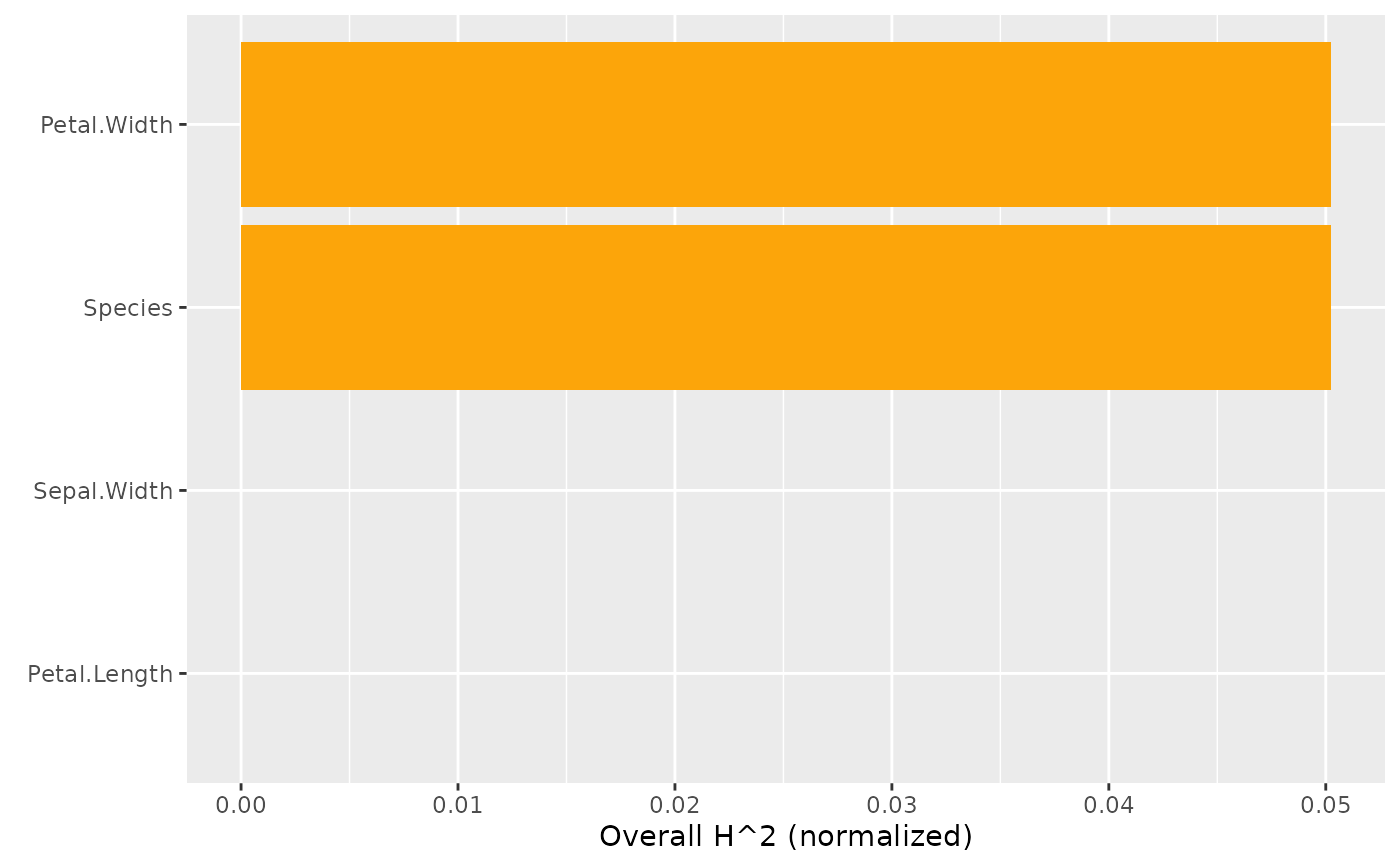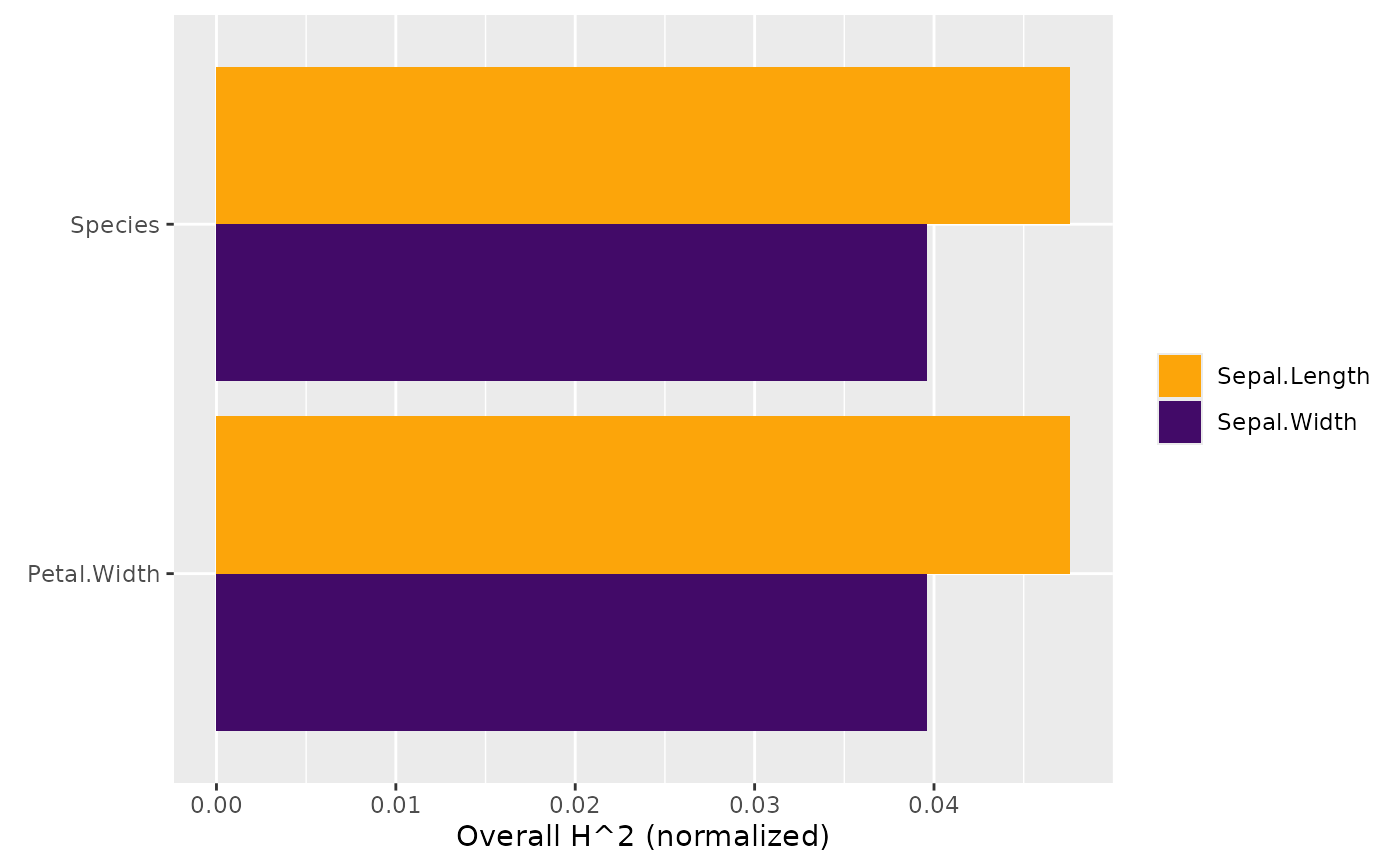Friedman and Popescu's statistic of overall interaction strength per
feature, see Details. Use plot() to get a barplot.
h2_overall(object, ...)
# Default S3 method
h2_overall(object, ...)
# S3 method for class 'hstats'
h2_overall(
object,
normalize = TRUE,
squared = TRUE,
sort = TRUE,
zero = TRUE,
...
)Arguments
- object
Object of class "hstats".
- ...
Currently unused.
- normalize
Should statistics be normalized? Default is
TRUE.- squared
Should squared statistics be returned? Default is
TRUE.- sort
Should results be sorted? Default is
TRUE. (Multi-output is sorted by row means.)- zero
Should rows with all 0 be shown? Default is
TRUE.
Value
An object of class "hstats_matrix" containing these elements:
M: Matrix of statistics (one column per prediction dimension), orNULL.SE: Matrix with standard errors ofM, orNULL. Multiply withsqrt(m_rep)to get standard deviations instead. Currently, supported only forperm_importance().m_rep: The number of repetitions behind standard errorsSE, orNULL. Currently, supported only forperm_importance().statistic: Name of the function that generated the statistic.description: Description of the statistic.
Details
The logic of Friedman and Popescu (2008) is as follows:
If there are no interactions involving feature \(x_j\), we can decompose the
(centered) prediction function \(F\) into the sum of the (centered) partial
dependence \(F_j\) on \(x_j\) and the (centered) partial dependence
\(F_{\setminus j}\) on all other features \(\mathbf{x}_{\setminus j}\), i.e.,
$$
F(\mathbf{x}) = F_j(x_j) + F_{\setminus j}(\mathbf{x}_{\setminus j}).
$$
Correspondingly, Friedman and Popescu's statistic of overall interaction
strength of \(x_j\) is given by
$$
H_j^2 = \frac{\frac{1}{n} \sum_{i = 1}^n\big[F(\mathbf{x}_i) -
\hat F_j(x_{ij}) - \hat F_{\setminus j}(\mathbf{x}_{i\setminus j})
\big]^2}{\frac{1}{n} \sum_{i = 1}^n\big[F(\mathbf{x}_i)\big]^2}
$$
(check partial_dep() for all definitions).
Remarks:
Partial dependence functions (and \(F\)) are all centered to (possibly weighted) mean 0.
Partial dependence functions (and \(F\)) are evaluated over the data distribution. This is different to partial dependence plots, where one uses a fixed grid.
Weighted versions follow by replacing all arithmetic means by corresponding weighted means.
Multivariate predictions can be treated in a component-wise manner.
Due to (typically undesired) extrapolation effects of partial dependence functions, depending on the model, values above 1 may occur.
\(H^2_j = 0\) means there are no interactions associated with \(x_j\). The higher the value, the more prediction variability comes from interactions with \(x_j\).
Since the denominator is the same for all features, the values of the test statistics can be compared across features.
Methods (by class)
h2_overall(default): Default method of overall interaction strength.h2_overall(hstats): Overall interaction strength from "hstats" object.
References
Friedman, Jerome H., and Bogdan E. Popescu. "Predictive Learning via Rule Ensembles." The Annals of Applied Statistics 2, no. 3 (2008): 916-54.
See also
Examples
# MODEL 1: Linear regression
fit <- lm(Sepal.Length ~ . + Petal.Width:Species, data = iris)
s <- hstats(fit, X = iris[, -1])
#> 1-way calculations...
#>
|
| | 0%
|
|================== | 25%
|
|=================================== | 50%
|
|==================================================== | 75%
|
|======================================================================| 100%
#> 2-way calculations...
#>
|
| | 0%
|
|======================================================================| 100%
h2_overall(s)
#> Overall H^2 (normalized)
#> Petal.Width Species Sepal.Width Petal.Length
#> 0.0502364 0.0502364 0.0000000 0.0000000
plot(h2_overall(s))
 # MODEL 2: Multi-response linear regression
fit <- lm(as.matrix(iris[, 1:2]) ~ Petal.Length + Petal.Width * Species, data = iris)
s <- hstats(fit, X = iris[, 3:5], verbose = FALSE)
plot(h2_overall(s, zero = FALSE))
# MODEL 2: Multi-response linear regression
fit <- lm(as.matrix(iris[, 1:2]) ~ Petal.Length + Petal.Width * Species, data = iris)
s <- hstats(fit, X = iris[, 3:5], verbose = FALSE)
plot(h2_overall(s, zero = FALSE))
